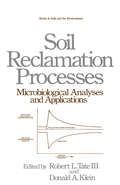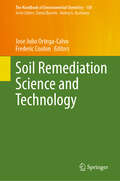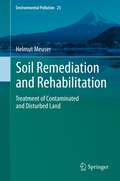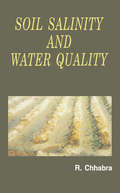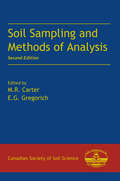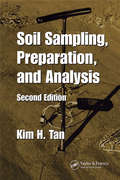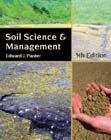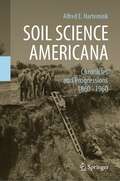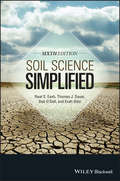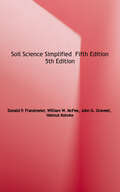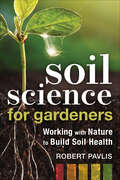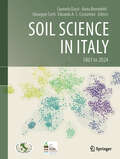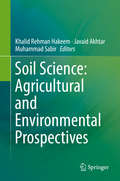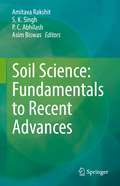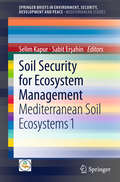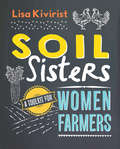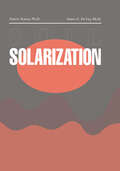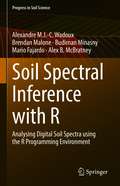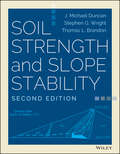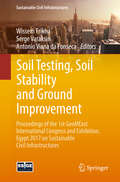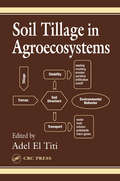- Table View
- List View
Soil Quality and Soil Erosion
by Rattan LalThis work examines the issue of accelerated soil erosion, which has become an increasingly serious concern in the twentieth century. Aspects considered include on-site impact of erosion; application of soil science to problems of non-agricultural uses of soil, such as mineland restoration, urban uses and disposal of urban wastes; soil contamination and pollution by industrial activities; and athletic and recreational uses of soil. Soil Quality and Soil Erosion will be a useful text for soil scientists, agronomists, foresters, and environmental scientists as we enter the next century.
Soil Reclamation Processes Microbiological Analyses and Applications
by Robert L. Tate Donald A. KleinThis book provides an assessment of the understanding of soil microbiology and biochemistry as part of reclamation processes. It attempts to assemble more specialized literature on reclamation, where application of microbiological concepts has provided the understanding of the process.
Soil Remediation Science and Technology (The Handbook of Environmental Chemistry #130)
by Jose Julio Ortega-Calvo Frederic CoulonThis book reviews the latest advances in soil remediation and is an authoritative account of the environmental chemistry, microbiology, ecotoxicology, and regulation policies of soil pollution. The book also discusses possible pathways for innovation, by incorporating state-of-the-art knowledge on sustainability, nature-based solutions, and socio-economical aspects. Divided into four parts, the book opens with an overview of the legal context and policy economy of soil pollution and remediation. The management of contaminated soils has a high cost and, although much of this cost is borne by companies, there is also high public spending. The strategic value of soil, the extensive costs associated with the remediation of many polluted sites throughout the World, and the current crisis demand for new solutions to soil remediation that are addressed in the following parts of the book. In this book, readers will find a comprehensive description of several remediation strategies by different pollution sources, nature-based solutions, and physicochemical methods for the remediation of contaminated soils. Particular attention is given to contaminated soils from industrial activities, urban settings, mining, and military activities. In the final chapter of the book, the editors present a perspective of the field, research trends and needs. Given its breadth, this book appeals to regulators, industrial scientists, and scholars alike.
Soil Remediation and Rehabilitation
by Helmut MeuserThis book provides a comprehensive overview of remediation and rehabilitation techniques and strategies for contaminated and anthropogenically disturbed land. Rehabilitation approaches in the urban environment, such as brownfield redevelopment and urban mining, are discussed. In relation to contaminated land, techniques for soil containment and decontamination of soil, soil vapour and groundwater are comprehensively and systematically presented. Complicated treatment techniques are schematically depicted and can be readily understood. Agricultural, silvicultural and environmentally sustainable rehabilitation strategies for reclaiming disturbed land/terrain in former mining or natural-resource extraction areas, such as open-cast mines, quarries, harvested peatlands, and subsided mining terrain (sinkholes), are introduced. This book will be a useful tool for students, researchers, private consultants and public authorities engaged in the treatment of contaminated or disturbed land.
Soil Salinity and Salt Resistance of Crop Plants
by Manzoor Qadir Sven SchubertThe book combines knowledge about salinity problems from soil science and plant science and presents an in-depth treatment of the current scientific findings to enable plant production on saline soils. It discusses soil parameters in the context of the development of plants with salt resistance as a multigenic trait. An integrated view helps to comprehend the complicated metabolic and biophysical aspects involved in salt resistance. Findings in recent years promise to promote salt resistance significantly. The possibility to cultivate plants on so far barren land is of utmost importance with regard to a fast-growing world population and an increasing need for food, feed, and regrowing resources under particular consideration of environmental protection.
Soil Salinity and Water Quality
by R. ChhabraThis volume covers such areas in the field of soil salinity and water quality as: origin and distribution of salt-affected soils; management of alkali soils; quality criteria of irrigation water; wastewaters as a source of irrigation; and grasses and trees in the management of salt-affected soils.
Soil Sampling and Methods of Analysis
by E. G. Gregorich M. R. CarterThoroughly updated and revised, this second edition of the bestselling Soil Sampling and Methods of Analysis presents several new chapters in the areas of biological and physical analysis and soil sampling. Reflecting the burgeoning interest in soil ecology, new contributions describe the growing number and assortment of new microbiological
Soil Sampling, Preparation, and Analysis (Books in Soils, Plants, and the Environment)
by Kim H. TanThis second edition of the popular Soil Sampling, Preparation, and Analysis provides a hands-on guide to the methods most commonly used in modern soil laboratories around the world, illustrating the methods with actual results. Divided into three sections, the book covers principles of soil sampling and sources of errors and variability of results, common procedures for extraction and analysis in soil plant testing, and instrumentation. The author added three new chapters on soil and plant test methods, electron microscopy, and nuclear magnetic resonance. He has extensively revised, updated, and expanded all of the other chapters to reflect recent advances and shifting interests in the field.
Soil Science & Management
by Edward J. PlasterThis textbook overviews the principles of biology and chemistry relevant to understanding the processes of soil formation and its management by farmers, horticulturists, and conservationists. Topics include the physical properties of soil, drainage and irrigation, plant nutrition, and amendments. The fourth edition updates data on national soil usage and erosion rates, and adds a section on human alteration of nitrogen cycles. Annotation (c)2003 Book News, Inc. , Portland, OR (booknews. com)
Soil Science Americana: Chronicles and Progressions 1860─1960
by Alfred E. HarteminkThis book narrates how the study of the soil became a science and institutionalized in the USA between 1860 and 1960. The story meanders through the activities, ideas, publications, and correspondence of people who influenced the progressions, that led to the budding and early blossoming of American and international soil science. Interwoven is a tale of two farm boys who grew up 900 km apart in the Midwest USA in the late 1800s and early 1900s. Emil Truog and Charles Kellogg met in the late 1920s and shared a natural connection to the soil. Both were practical pioneers and believed that understanding soils was crucial to helping people on the land make a better living. The USA is a big country, its soil science is geographically intertwined, and the cradle of its history primes back to a few people. “Soil Science Americana is an intellectual biography, not of one individual but of a new scientific field from its emergence to its complete coming of age.”— Louise O. Fresco, President, Wageningen University and Research“In a lively, personal voice, Hartemink traces the roots of modern soil science in the United States…creating a book that will engage both the expert and non-expert in the underappreciated field of soil science.”— Jo Handelsman, Director, Wisconsin Institute for Discovery“The intellectual master piece is of interest to soil scientists, general public and the policy makers, and will remain pertinent for generations to come.”— Rattan Lal, World Food Prize Laureate 2020, The Ohio State University
Soil Science Simplified
by Thomas J. Sauer Aga Razvi Neal Eash Forbes WalkerAlready renowned as a user-friendly beginners' guide to soil science, Soil Science Simplified, 6th Edition is an updated version of the beloved textbook that includes even more thorough applications of soil science to interdisciplinary fields. It includes the most recent research concerning uses of soil in municipal, engineering, and other areas, conversion agriculture covering no-till, hoe-till, and the methodology of cover crops, crop rotations, N contribution, and worldwide trends in conversion agriculture. The experienced authors have fully revised and updated the fundamental chapters on physical, chemical, and biological properties to create an ideal introductory text.
Soil Science Simplified
by Helmut Kohnke Donald P. Franzmeier William W. McFee John G. GraveelThroughout its previous four editions, Soil Science Simplified has helped generations of students understand the basic concepts and scientific principles of soils. The Fifth Edition expands on that foundation, providing a perfect overview for those seeking a concise, practical introduction to the subject. The authors' combined 100 years of teaching experience result in a handbook that won't confuse or intimidate students. The Fifth Edition retains the text's solid grounding in classification, genesis, and morphology of soils. New chapters cover such contemporary topics as soil mineralogy, soil moisture regimes, current soil survey practices, and how soil management practices directly affect the quality of a variety of water resources.
Soil Science Working for a Living
by David Dent Yuriy DmytrukThis book discusses gritty issues that society faces every day: food and water security, environmental services provided by farmers, almost accidentally, and taken for granted by everyone else, the capability of the land to provide our needs today and for the foreseeable future and pollution of soil, air and water. The chapters are grouped in four main themes: soil development - properties and qualities; assessment of resources and risks; soil fertility, degradation and improvement and soil contamination, monitoring and remediation. It is a selection of papers presented at the Pedodiversity in Space and Time Symposium held at Chernivtsi National University, Ukraine, 15-19 September 2015.
Soil Science for Gardeners: Working with Nature to Build Soil Health
by Robert PavlisBuild healthy soil and grow better plantsRobert Pavlis, a gardener for over four decades, debunks common soil myths, explores the rhizosphere, and provides a personalized soil fertility improvement program in this three-part popular science guidebook.Healthy soil means thriving plants. Yet untangling the soil food web and optimizing your soil health is beyond most gardeners, many of whom lack an in-depth knowledge of the soil ecosystem.Soil Science for Gardeners is an accessible, science-based guide to understanding soil fertility and, in particular, the rhizosphere – the thin layer of liquid and soil surrounding plant roots, so vital to plant health.Coverage includes:Soil biology and chemistry and how plants and soil interactCommon soil health problems, including analyzing soil's fertility and plant nutrientsThe creation of a personalized plan for improving your soil fertility, including setting priorities and goals in a cost-effective, realistic time frame.Creating the optimal conditions for nature to do the heavy lifting of building soil fertilityWritten for the home gardener, market gardener, and micro-farmer, Soil Science for Gardeners is packed with information to help you grow thriving plants.
Soil Science in Italy: 1861 to 2024
by Anna Benedetti Carmelo Dazzi Edoardo A.C. Costantini Giuseppe CortiHistory is generally defined as “the study of past events, particularly in human affairs” and is mostly understood when presented chronologically. That’s why someone also defined it as the ‘chronological record of the past’. Knowing the past is extremely important for any society and human being. Past gives us insights into our evolving behavior in many matters of life. The book is seen as a unique opportunity to preserve the memory of the Italian history of soil science. It represents a milestone and a cultural heritage. Moreover, the book is a sort of ideal bridge between the pioneers of soil science in Italy and the young generation of researchers, contributing to spreading awareness of the importance of soil as a fundamental resource.
Soil Science: Agricultural and Environmental Prospectives
by Khalid Rehman Hakeem Javaid Akhtar Muhammad SabirSoil is the most important natural non-renewable resource developed over a longer period of time due to weathering of rocks and subsequently enrichment of organic matter. Soil provides habitat for numerous microorganisms and serves as a natural medium for plant growth, thereby providing the plants with anchorage, nutrients and water to sustain the growth. Soil also serves as a universal sink for all types of pollutants, purifies ground water and is a major reserve of carbon in the universe. The role of soils to provide ecosystem services, maintenance of environmental/human health and ensuring the food security makes it as the most important and basic natural resource. Soil Science helps us to elaborate and understand how the soils provide all these services. Soil Science also provides us the basic knowledge dealing with the origin of the soil parent material, weathering of parent material and the formation of soils, morphological, physico-chemical and biological features of soils, classification of soils and role of soils in the provision and maintenance of ecosystem services, food security and environmental quality. This book encompasses the various processes, functions and behaviour of soils very comprehensively to acquaint the students of soil, plant and environmental sciences about their role to perform different agricultural and environmental functions.
Soil Science: Fundamentals to Recent Advances
by Amitava Rakshit S. K. Singh P. C. Abhilash Asim BiswasThis compilation has been designed to provide a comprehensive source of theoretical and practical update for scientists working in the broad field of soil science. The book explores all possible mechanisms and means to improve nutrient use efficiencies involving developing and testing of nanofertilizers, developing consortia based microbial formulations for mobilization of soil nutrients, and engineering of nutrient efficient crops using molecular biology and biotechnological tools. This is an all-inclusive collection of information about soil science. This book is of interest to teachers, researchers, soil scientists, capacity builders and policymakers. Also the book serves as additional reading material for undergraduate and graduate students of soil science, quantitative ecology, earth sciences, GIS and geodetic sciences, as well as geologists, geomorphologists, hydrologists and landscape ecology. National and international agriculture and soil scientists, policy makers will also find this to be a useful read.
Soil Security for Ecosystem Management: Mediterranean Soil Ecosystems 1
by Sabit Erşahin Selim KapurThe term "Soil Security" is used in the context of maintaining the quality and quantity of soil needed in order to ensure continuous supplies of food and fresh water for our society. Topics in this unique book on the management of soil sustainability in the Mediterranean region include: soil information, land degradation, land desertification, pedoenvironments, and the carbon cycle and sequestration. One main focus of the book is the description of new approaches that have been adapted with regards to interdisciplinary soil ecosystem management to combat and mitigate desertification. The contributing authors are renowned experts in their fields which cover the subjects on traditional as well as innovative land use and management.
Soil Settlement and the Concept of Effective Stress and Shear Strength Interaction
by Mohd Jamaludin NoorThis book is about the principal concept of soil mechanics that become the basis in explaining the soil mechanical behaviours. It is the extended concept of effective stress of Terzaghi and it is known as "the concept of effective stress and shear strength interaction." This new concept incorporates the role of mobilised shear strength developed within the soil body in resisting the compressive effect. Based on this new concept a comprehensive soil volume change framework has been developed known as Rotational Multiple Yield Surface Framework (RMYSF). This RMYSF is able to explain and quantify the puzzled and complex soil volume change behaviours. The main advantage of this RMYSF is that it is able to make a good prediction of soil and rock stress-strain responses at any effective stress. This will lead to accurate prediction of soil and rock settlements. Due to its simplicity and the comprehensive nature of this new fundamental concept in soil and rock mechanics, it will eventually be included in soil and rock mechanics syllabus for undergraduate and postgraduate courses. This book would be very useful for geotechnical engineers dealing with soil settlement, underground excavation, computer modelling, rock mechanics, road engineering, earth and rock dam engineering and tunnel engineering.
Soil Sisters
by Lisa KiviristWomen in agriculture are sprouting up in record numbers, but they face a host of distinct challenges and opportunities. Blending What Color is Your Parachute-style career advice with sustainable agriculture practices viewed through a gender lens, Soil Sisters provides a wealth of invaluable information for fledging female farming entrepreneurs.The first manual of its kind, this authoritative and comprehensive blueprint presents practical considerations from a woman's perspective, covering everything from business planning to tool use and ergonomics to integrating children and family in farm and field operations. Key topics include: Finding your niche: mid-life encore careers, younf and beginning, Boomerangs, and more From concept to crop: diversified farm start-up basics Resources, grants, and loans available especially for women farmers.Soil Sisters also contains case studies, inspirational ideas, and savvy advice nuggets from over one hundred successful women farmers and advocates. Targeted specifically to members of the fastest-growing demographic in local agriculture, this highly readable guide is practical and pragmatic "Chick Lit" for today's food scene. Lisa Kivirist is Senior Fellow, Endowed Chair in Agricultural Systems at the Minnesota Institute for Sustainable Agriculture and a national advocate for women in sustainable agriculture. She founded and directs the Rural Women's Project of the Midwest Organic Sustainable Education Service, an award-winning initiative championing female farmers and food-based entrepreneurs. Together with her husband, John Ivanko, Lisa is co-author of Homemade for Sale, Farmstead Chef, ECOpreneuring, and Rural Renaissance. Lisa and her family run Inn Serendipity Farm and Bed & Breakfast, completely powered by the wind and sun in the rolling green hills of southern Wisconsin.
Soil Solarization
by Jaacov Katan James E. DeVaySoil Solarization describes the principles and technology of soil solarization and the use of soil solarization for different crops and cropping systems. The book evaluates and interprets the extensive amount of literature available on soil solarization in relation to climatic effects and changes in populations of soil-borne microorganisms and weeds. It also compares the advantages and disadvantages of soil solarization with other methods of soil disinfestation, such as soil steaming and fumigation. Soil Solarization explores the effects of soil solarization, covering such points as biological control, changes in soil chemistry involving mineral elements, as well as other changes, such as soil salinity and soil structure. It is suitable for solarizers, researchers working with soil-borne pathogens and soil microbiology, plant protection experts, and other plant researchers and extension specialists.
Soil Spectral Inference with R: Analysing Digital Soil Spectra using the R Programming Environment (Progress in Soil Science)
by Budiman Minasny Alex B. McBratney Alexandre M.J.-C. Wadoux Brendan Malone Mario FajardoThis book provides a didactic overview of techniques for inferring information from soil spectroscopic data, and the codes in the R programming language for performing such analyses. It is intended for students, researchers and practitioners looking to infer soil information from spectroscopic data, focusing mainly on, but not restricted to, the infrared range of the electromagnetic spectrum. Little prior knowledge of the R programming language or digital soil spectra is required. We work through the steps to process spectroscopic data systematically.
Soil Strength and Slope Stability
by J. Michael Duncan Stephen G. Wright Thomas L. BrandonThe definitive guide to the critical issue of slope stability and safety Soil Strength and Slope Stability, Second Edition presents the latest thinking and techniques in the assessment of natural and man-made slopes, and the factors that cause them to survive or crumble. Using clear, concise language and practical examples, the book explains the practical aspects of geotechnical engineering as applied to slopes and embankments. The new second edition includes a thorough discussion on the use of analysis software, providing the background to understand what the software is doing, along with several methods of manual analysis that allow readers to verify software results. The book also includes a new case study about Hurricane Katrina failures at 17th Street and London Avenue Canal, plus additional case studies that frame the principles and techniques described. Slope stability is a critical element of geotechnical engineering, involved in virtually every civil engineering project, especially highway development. Soil Strength and Slope Stability fills the gap in industry literature by providing practical information on the subject without including extraneous theory that may distract from the application. This balanced approach provides clear guidance for professionals in the field, while remaining comprehensive enough for use as a graduate-level text. Topics include: Mechanics of soil and limit equilibrium procedures Analyzing slope stability, rapid drawdown, and partial consolidation Safety, reliability, and stability analyses Reinforced slopes, stabilization, and repair The book also describes examples and causes of slope failure and stability conditions for analysis, and includes an appendix of slope stability charts. Given how vital slope stability is to public safety, a comprehensive resource for analysis and practical action is a valuable tool. Soil Strength and Slope Stability is the definitive guide to the subject, proving useful both in the classroom and in the field.
Soil Testing, Soil Stability and Ground Improvement: Proceedings of the 1st GeoMEast International Congress and Exhibition, Egypt 2017 on Sustainable Civil Infrastructures (Sustainable Civil Infrastructures)
by Wissem Frikha Serge Varaksin Antonio Viana da FonsecaEarthwork projects are critical components in civil construction and often require detailed management techniques and unique solution methods to address failures. Being earth bound, earthwork is influenced by geomaterial properties at the onset of a project. Hence, an understanding of the in-situ soil properties is essential. Slope stability is a common problem facing earthwork construction, such as excavations and shored structures. Analytical methods for slope stability remain critical for researchers due to the mechanical complexity of the system. Striving for better earthwork project managements, the geotechnical engineering community continues to find improved testing techniques for determining sensitive properties of soil and rock, including stress-wave based, non-destructive testing methods. To minimize failure during earthwork construction, past case studies and data may reveal useful lessons and information to improve project management and minimize economic losses. This volume is part of the proceedings of the 1st GeoMEast International Congress and Exhibition on Sustainable Civil Infrastructures, Egypt 2017.
Soil Tillage in Agroecosystems (Advances in Agroecology)
by Adel El TitiBuilding on our knowledge of soil ecology under natural, undisturbed conditions, Soil Tillage in Agroecosystems focuses on how cultivation affects soil and the soil environment. In particular, it highlights how methods of soil tillage can influence soil structure, soil chemical processes, soil borne pathogens, and pest species. Covering the aspects of soil tillage on different taxa, the book concludes with a synthesis of the role of soil tillage in securing a sustainable agricultural environment. It provides the scientific basis for choosing different tillage options to achieve the best possible sustainable base for long-lasting agricultural production.

